
1
Airspeed Ambassador
The sleek Airspeed Ambassador was one of the many DC-3 replacements, which didn't. A total of 21 were built, originally going to BEA as The famous "Elizabethan". It later found a home with Dan Air, BKS, and Autair as shown on the above postcard.
| 
2
Armstrong Whitworth Argossy
First flown in 1959, the exotic Argossy was conceived as a military design, then repurposed as a civilian airliner, and ultimately sold mostly as a military transport. A total of 74 were built, 55 of which went to the RAF. The SAFE aircraft shown in this Felicity Postcard issue was equipped with a pressurized passenger cabin. The last Argossy flight was in 1991
| 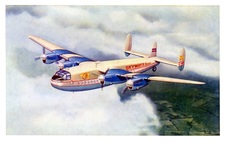
3
Avro York
The Avro York was an airliner derived from the rugged Lancaster Bomber, first delivered to BOAC in 1944. It served as a long range transport for various airlines including F.A.M.A. of Argentina. Skyways as shown in the above airline issue, was the last operator of the York in 1964. A total of 44 Civilian Yorks were built
| 
4
Avro Tudor
The Tudor, somewhat derived from the Lincoln Bomber just couldn't get off the ground, so to speak. Supposedly built for BOAC, the airline ultimately refused the aircraft in 1947. The Tudor IV operated for British South American, as shown above, but had a bad habit of disappearing into the Bermuda Triangle. Other crashes and performance issues contributed to its demise. I believe the last Tudor operations were by Air Charter Ltd in 1959. I'd love to have a postcard of that one!
|

5
BAE 146
The BAE 146, originally a Hawker Siddley concept, first flew in 1983, and had a successful production of 387 aircraft. First operated by Dan Air (I believe), it found a home with numerous airlines around the world. The Air Baltic shown in the above airline issue, is one of the more advanced version, the RJ-70
| 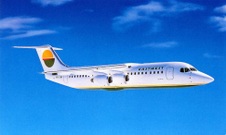
6
BAE-146-300
The largest of the 146's, this is an East West Issue of the 146-300
| 
7
Bristol 170
The Bristol 170 first flew in 1946 and proved to be a versatile passenger/freighter. Its most notable mission became transporting passengers with their cars from Great Britain to the Continent. A total of 214 were built between 1945 and 1958. The West African shown above is one of very few color cards of the airliner
| 
8
Bristol Britannia
Like many British Airliners the Britannia development was plagued by engine problems and other issues, which negatively impacted sales. Eighty Five of the "Whispering Giants" were ultimately built, with the last going to Ghana in 1961. Once in service the Britannia proved to be an effective intercontinental airliner. Above is an Air Spain Issue of the 300 model.
|

9
British Aircraft ATP
An airliner whose time had come, and gone. The advanced HS-748 arrived in the market a little late and developed very little interest. The beautiful SATA version is shown on the above card. The ATP was seen in much of the US as United Express. A total of 64 were built.
| 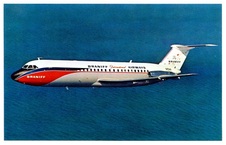
10
British Aircraft BAC-111-200
The "Pocket Rocket" was a British airliner that beat its competitors to market. It was launched by British United Airways and quickly followed by orders from Braniff, Mohawk and Aer Lingus. Aloha and American added to the US order book. First revenue flight was on 22Jan65, and 244 of the various models were delivered. The beautiful Braniff shown above was one of the first US deliveries
| 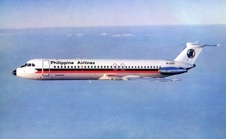
11
BAC-111-500
A very nice Philippine / BAC oversized issue of the BAC-111-500
| 
12
British Aircraft J-31 Jetstream
First flown in March 1980 the J-31 Jetstream sold 386 airliners to operators World Wide. Faster and more comfortable than Beechcraft & Embraer competitors, the J-31 found its way into many US major airlines fleets. An additional 100 stretched J-41s were put in service between 1992 and 1997. The J-31 shown in a beautiful Regional Issue is one of my favorites.
|
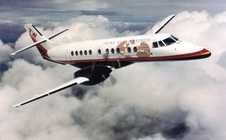
13
J-41 Jetstream
The J-41 flew in the beautiful final colors of TWA. A Plane Views issue I had to include.
| 
14
Britten Norman Islander
Britten Norman began development of the 9 seat Islander in 1963. First flown in 1967 the Islander has sold some 1280 units including licensed production in Romania and other countries. The aircraft shown in the above LIAT Issue, is typical of the airlines and missions that Islanders so successfully have accomplished.
| 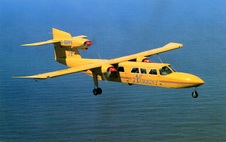
15
Britten Norman Trislander
The Trislander derivative of the Islander competed in the 18 seat market with a number of other players. It has excellent STOL performance, but little impact in the market. Aurigny as shown in the above airline issue, operated as many as 16 of the 73 Trislanders built
| 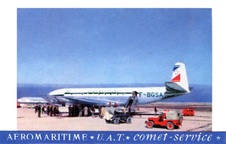
16
DeHavilland Comet 1
First flown in 1949 and delivered in 1952, the Comet changed the landscape of commercial airliners forever. Sadly, unanticipated fatigue issues caused the loss of several aircraft. The operational disasters were ultimately diagnosed and corrected, speeding the development of future jetliners, despite essentially killing the Comet. Among the first Comet operators was UAT as shown in the very nice card above
|

17
DeHavilland Comet 4C
The finished product of the Comet experiment was the Comet 4. It served splendidly from 1958-1980, pioneering Trans Atlantic Jet service and operating international jet routes world wide. Sadly, only 77 were built, of which as many as 46 ended up with Dan Air. Among the first customers for the 4 series was East African, shown in this uncommon airline issue
| 
18
DeHavilland Dove
The outstanding little DeHavilland Dove was in production from 1946-1967 with 542 produced. Intended as an 11 seat successor to the Dragon Rapide, the Dove helped to launch the US Commuter airlines, in service with TAG, Executive, and Apache. Shown above is a very nice Morton Air services Issue.
| 
19
DeHavilland Dragon Rapide
The Dragon Rapide was a development of the 1932 Dragon design which operated for airlines before WW II. Over 500 additional were built for the war effort, creating a total of 731 Rapides.
The aircraft was economical and durable, and flew in commercial service long after the war. The Air Kruise Issue shown above is my favorite card of the Dragon.
| 
20
Dehavilland Drover
Not truly a British Aircraft, as it was an Australian tri motor design derived from the Dove. Had an unfortunate habit of shedding propellers in flight, that brought down a number of aircraft. Brakes that didn't work were another drawback. As a result, only 20 were built. Most, including all of Trans Australia's became air ambulances, apparently under the theory that those passengers didn't have a lot to lose.
One of only 2 Drover postcards, This Fiji issue was posted in 1960.
|

21
DeHavilland Heron
The Heron appeared in the early 50s, and survived mostly as Riley Turbo conversions up into the 1990s. A number of the 150 aircraft built appeared with US Commuter airlines such as Swiftair, Susquehanna, and Various Allegheny Commuters. Shown is a beautiful Prinair issue of the Riley Heron
| 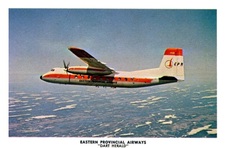
22
Handley Page Dart Herald #1
The beautiful Herald, shown in this Eastern Provincial issue was another proposed DC-3 replacement, which ultimately resulted in 48 DC-3's replaced. A victim of a stubbornly dysfunctional process that led to its introduction with 4 piston engines, while Fokker and Hawker Siddley moved forward with twin Rolls Royce Darts. Ultimately, the Dart powered Herald emerged, an excellent performer, but far behind its rivals.
| 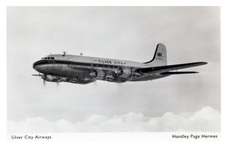
23
Handley Page Hermes #1
Like a number of British airliners the Hermes began by crashing the prototype, and like most, an initial order from BOAC was delayed pending resolution of performance issues. The BOAC Aircraft operated off and on for 4 years, and were disbursed among a number of charter airlines such as Skyways, Airwork, and Silver City, as shown on the above Silver City Issue. A total of 29 Hermes were built. The final Hermes operation was in December 1964
| 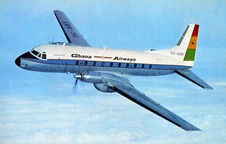
24
Hawker Siddley HS-748
The HS-748, originally an Avro design joined in the DC-3 replacement contest. Despite being a little behind the F-27, the 748 program progressed well and demonstrated excellent short field performance. This characteristic allowed Air Illinois to operate 748s in and out of Meigs Field in downtown Chicago. Some 380 of the rugged 748s were built, a number of which are still operating. The Ghana Airways issue above is my favorite card of the aircraft.
|
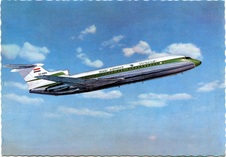
25
Hawker Siddley Trident 1
The Trident, a DeHavilland design, was afflicted by a continuously evolving requirement for BEA. which ultimately resulted in the TriJet configuration launched as the Trident 1C. It incorporated significant technology including the first Cat.3C Autoland.
Sadly, the competing 727 with more advanced wing and better take off performance captured most of the Trident's potential market. A total of 117 Tridents were produced, including the 1E, 2E, and 3B versions. The splendid Iraqi issue above is one of my favorite postcards
| 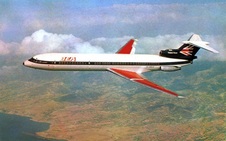
26
Trident 3
The largest Trident, complete with a fourth engine for take off, was only purchased by BEA. Above is my favorite BEA Issue
| 
27
Scottish Aviation Twin Pioneer
A true STOL aircraft, the Twin Pioneer first flew in 1955. Its short field, unimproved runway performance found favor with military users, but few made
their way into civilian service.
The common Spanjersberg issue of the Borneo aircraft is the only card I've seen of the Twin Pioneer. Only 87 were built.
| 
28
Shorts Belfast
No one seems sure what the mission for the Belfast really was, but a total of 10 were built capable of hauling missiles and other oversized loads to remote worldwide destinations. It was offered as a commercial freight aircraft, but had no response. Later purchased from the RAF Heavylift found it to be an excellent heavy freighter, with full autoland capability, no less. Heavylift was thoughtful enough to produce some nice cards of the Belfast, including the excellent airline issue above.
|
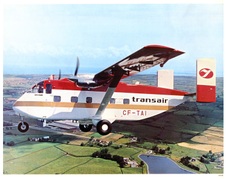
29
Shorts Skyvan
The rather homely Shorts Skyvan served as both a 19 seat commuter airliner and small freighter complete with oversized rear door for easy loading. First flown in 1963, production continued to 1986. A total of 153 were built, with most in freight or other specialty duties. Olympic was a significant operator of the Skyvan for inter island services, and issued an oversized card. The Transair shown above is also oversized, and may be a Shorts issue.
| 
30
Shorts SD-330
The SD-330 was a development of the Skyvan, first flown in 1975. It was reasonably well received by the commuter airlines, and a total of 136 were produced. Today most remaining aircraft are light freighters. Shown is a Command Airways issue, one of my favorite cards
| 
31
Shorts SD-360
The 360 was a further development of the old Skyvan, with a stretch to accommodate up to 39 passengers, and modified rear fuselage and tail. First flown in 1981, 165 were produced. Shown above is a nice Aer Lingus Issue.
| 
32
Shorts Sandringham
The Sandringhams were civil conversions of the RAF Sutherland, entering service with BOAC around 1947, and operating for a number of airlines such as TEAL, Ansett, Qantas, and later Antilles Air Boats. It also found service with DNL Norwegian Airlines as shown in this uncommon DRC Issue. The DNL was radar equipped, seating 37 passengers. Approximately 20 were put in service.
|

33
Shorts Solent
The first S-45 Solent flew in 1946, with production ending in 1949. (A total of 23 produced) BOAC operated the Solent until 1950, but TEAL continued to operate the Solent until 1960, and produced the nice card shown above.
| 
34
Vickers Vanguard
The beautiful Vanguard was another aircraft designed to fill a BEA requirement, often the kiss of death for an airliner program. Actually an excellent performer, it was in operation from late 1960 to 1974 and with substantial power, found real favor as a freighter. Only 44 were produced, and strangely BEA never issued a Vanguard postcard. Shown is a very nice Europe Aero Service Issue.
| 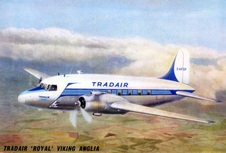
35
Vickers Viking
Maybe the first "DC-3 replacement" the Viking was a very early post war design. Like several others the prototype crashed, but it developed into a reliable and rugged airliner. In 1948 a Viking Jetliner was successfully tested and then reconverted to piston engines. Production stopped in 1948 with 163 aircraft completed. The Viking served with airlines from Argentina to South Africa to Asia as well as European operators like Danish, LTU, Condor, & Aer Lingus. The Tradair issue shown above is one of few color cards of the Viking.
| 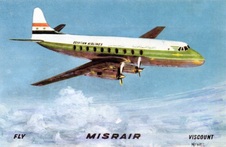
36
Vickers Viscount 700
While the Comet was a revolution, the Viscount truly changed the landscape of commercial aviation. Enormously popular with passengers, it had the ability to alter the competitive landscape, particularly demonstrated by Capital's success with the airliner. The first Viscount 630 services began with BEA in 1950, followed by an order for 20 of the stretched 700 model, which went into service in 1953. The rest is history, so to speak. Some 445 Viscounts were sold and operated world wide. Misrair of Egypt, also a Viking operator, was one of the early orders, in 1951. This beautiful card is another of my favorites.
|

37
Viscount 600
The original model 630 Viscount which operated briefly for BEA, a rare BEA issue
| 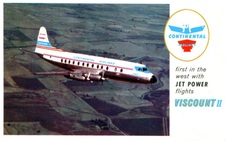
38
Viscount 800
The uncommon 1st Continental Issue introducing the Viscount 800.
| 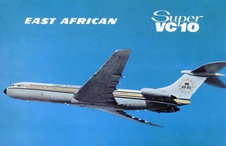
39
Vickers Super VC-10
In my view the most beautiful airliner, the VC-10 emerged as a more powerful aircraft than its competitors, with better "hot & high" and short field performance. Unfortunately, the airline world was not impressed, and only 54 were produced, almost entirely for BOAC and the RAF. East African, however, marketed the aircraft enthusiastically, and produced a number of excellent postcards.
| 
40
VC-10-1100
The shorter 1100 series VC-10 shown on this beautiful Air Malawi Issue.
|